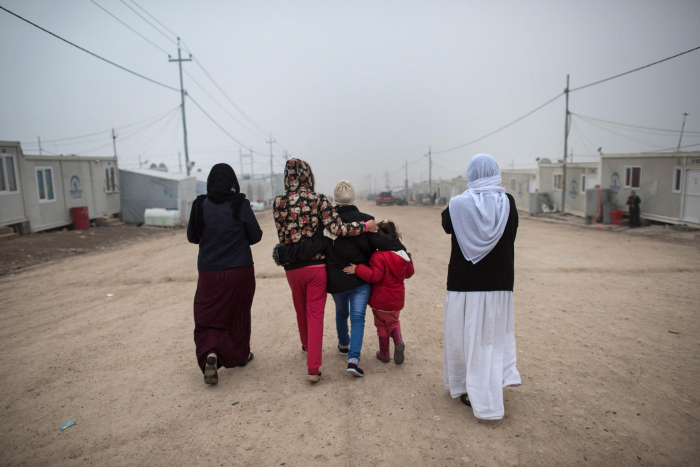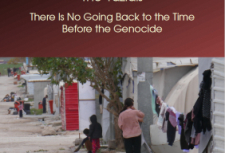ISIS’ Use of Sexual Violence as a Strategy of Terrorism in Iraq

Beatrice Aubert
Sexual violence in Iraq, from the State to ISIS
This third part of article will aim to identify the impact that previous conflicts and use of violence in Iraq by the state has had on the systematic use of sexual violence as a strategy of terrorism by ISIS. It will also identify how ISIS uses sexual violence to assert dominance over ethnic and religious minorities. This essay will argue that Iraq cultivated a breeding ground for sexual violence from which ISIS took score, as it was already a very common practice used by the Iraqi government and security services. For example, Saddam Hussein already used sexual violence as a way to sustain ethno-sectarian hierarchies in Iraq . Sexual enslavement, a widespread practice used by ISIS, was a technique well-used by the Iraqi regime in the 1980s at the time of the ethnic cleansing of Iraqi Kurdistan . Some scholars have argued that sexual violence in conflicts is more widespread in countries with higher levels of institutionalized gender discrimination (Kaya, 2019 p.9). Cohen adds to that idea that insurgent perpetrated acts of mass rape are more likely in a context of state collapse, as exemplified in Iraq. Building on these two assumptions, we will try to show that the Iraqi state facilitated the use of sexual violence by ISIS.
Mackenzie highlights the importance of accounting of accounting wartime rape not only as a tool of war but also as a side effect of a patriarchal society (Mackenzie, 2010 p.208). After the invasion of Iraq in 2003, the state failed to provide security, and this failure has particularly exposed women to domestic violence, and violence by public authorities against women (O’Driscoll, 2018 p.15). The increase of sectarian violence in Iraq in the last three decades has also facilitated the use of killings, rape and the kidnapping of women to settle scores between communities (Kaya, 2019 p.13). The Iraqi state has been noted for its failure to achieve and implement justice, and in the cases of sexual violence, the state often punishes the victim rather than the perpetrator (Dahham, 2016 p.11; Kaya, 2019 p.13). This is further illustrated in the reduction of sentences in the Iraqi penal code for honour killings (UNAMI, 2013 p.2). The state has done very little to combat human trafficking and mass rape, leaving the victims with no institutions to rely on (Kaya, 2019 p.13). A lack of legislation and institutions legitimises the use of gendered violence in Iraq. This account of the acceptance of gender-based violence in Iraq due to the failure of the state to protect women highlights the context in which ISIS asserted its dominance in 2014 after the invasion of Mosul. Drawing on the norms that were already in place in Iraq, ISIS created a gendered socio-economic structure based on the already existing Iraqi norms of gender discrimination and violence (Kaya, 2019 p.12.; Ahram, 2015 p.58).
Sexual violence allows ISIS to reinforce its neo-patriarchal control, to build cohesion between its ranks and to attract foreign fighters, by promising them women as spoils of war (Ahram, 2015 p.67). The most characteristic use of sexual violence by ISIS is the use of sexual enslavement of women and girls of ethnic or religious minorities. By enslaving them, the group asserts its dominance over the community and also ensures a major revenue source by the sale of women to brothels or to private individuals (Ahram, 2015 p.67). ISIS can control the reproductive ability of the whole community and entirely destroy its social structure by separating the men and women (Kaya, 2019 p.7; Ahram, 2015 p.70).
Finally, ISIS’s specificity in its use of sexual violence is that it publicly displays its crimes. The group records their actions on social media to gain a reputation of brutality to create fear and admiration for the organisation, and to terrorise its enemies (Amnesty International, 2014 p.11). ISIS employs a systematic use of sexual violence that seems particularly targeted towards ethnic and religious minorities, and that serves the purpose of better controlling them to eventually destroy them.
This section has demonstrated that the use of sexual violence by ISIS in Iraq is not a new phenomenon, as the Iraqi state has largely participated in creating a breeding ground for such violence in the last few decades. ISIS has used the foundations of sexual violence laid by the state in the larger concept of their state-building strategy. By making sexual violence acceptable, it becomes an effective tool of both terror and ethnic cleansing which is at the disposal of the group.
Conclusion
To conclude, this essay has used the case study of the Yazidi community to assess why the terrorist organisation ISIS used sexual violence in the internal conflict that started in Iraq in 2014. This study has proposed an overview of the debate on sexual violence through a literature review highlighting the different strategies that could be defined as reasons for the use of sexual violence in a conflict. This essay applied this theoretical approach to a more concrete example of ISIS in Iraq. It shows that it was crucial to observe sexual violence in the larger context of state building and as a phenomenon that had foundations in deeply rooted gender stereotypes promulgated by the previous governments and social order. Finally, studying the case of the Yazidi community provided evidence on how terrorist groups can resort to sexual violence as a strategy of ethnic cleansing. We have found that sexual violence was an important weapon to consider when analyzing the strategic aims of an organization in a conflict. This paper adds to existing argument on why sexual violence is so recurrent in conflicts and why women and minorities are particularly targeted.
Tags: #yazidisinfo #newsyazidi #aboutyazidi #genocideyazidi #womanrights #harassment #sexualharassment #girlspower
ISIS’ Use of Sexual Violence as a Strategy of Terrorism in Iraq

Beatrice Aubert
Sexual violence in Iraq, from the State to ISIS
This third part of article will aim to identify the impact that previous conflicts and use of violence in Iraq by the state has had on the systematic use of sexual violence as a strategy of terrorism by ISIS. It will also identify how ISIS uses sexual violence to assert dominance over ethnic and religious minorities. This essay will argue that Iraq cultivated a breeding ground for sexual violence from which ISIS took score, as it was already a very common practice used by the Iraqi government and security services. For example, Saddam Hussein already used sexual violence as a way to sustain ethno-sectarian hierarchies in Iraq . Sexual enslavement, a widespread practice used by ISIS, was a technique well-used by the Iraqi regime in the 1980s at the time of the ethnic cleansing of Iraqi Kurdistan . Some scholars have argued that sexual violence in conflicts is more widespread in countries with higher levels of institutionalized gender discrimination (Kaya, 2019 p.9). Cohen adds to that idea that insurgent perpetrated acts of mass rape are more likely in a context of state collapse, as exemplified in Iraq. Building on these two assumptions, we will try to show that the Iraqi state facilitated the use of sexual violence by ISIS.
Mackenzie highlights the importance of accounting of accounting wartime rape not only as a tool of war but also as a side effect of a patriarchal society (Mackenzie, 2010 p.208). After the invasion of Iraq in 2003, the state failed to provide security, and this failure has particularly exposed women to domestic violence, and violence by public authorities against women (O’Driscoll, 2018 p.15). The increase of sectarian violence in Iraq in the last three decades has also facilitated the use of killings, rape and the kidnapping of women to settle scores between communities (Kaya, 2019 p.13). The Iraqi state has been noted for its failure to achieve and implement justice, and in the cases of sexual violence, the state often punishes the victim rather than the perpetrator (Dahham, 2016 p.11; Kaya, 2019 p.13). This is further illustrated in the reduction of sentences in the Iraqi penal code for honour killings (UNAMI, 2013 p.2). The state has done very little to combat human trafficking and mass rape, leaving the victims with no institutions to rely on (Kaya, 2019 p.13). A lack of legislation and institutions legitimises the use of gendered violence in Iraq. This account of the acceptance of gender-based violence in Iraq due to the failure of the state to protect women highlights the context in which ISIS asserted its dominance in 2014 after the invasion of Mosul. Drawing on the norms that were already in place in Iraq, ISIS created a gendered socio-economic structure based on the already existing Iraqi norms of gender discrimination and violence (Kaya, 2019 p.12.; Ahram, 2015 p.58).
Sexual violence allows ISIS to reinforce its neo-patriarchal control, to build cohesion between its ranks and to attract foreign fighters, by promising them women as spoils of war (Ahram, 2015 p.67). The most characteristic use of sexual violence by ISIS is the use of sexual enslavement of women and girls of ethnic or religious minorities. By enslaving them, the group asserts its dominance over the community and also ensures a major revenue source by the sale of women to brothels or to private individuals (Ahram, 2015 p.67). ISIS can control the reproductive ability of the whole community and entirely destroy its social structure by separating the men and women (Kaya, 2019 p.7; Ahram, 2015 p.70).
Finally, ISIS’s specificity in its use of sexual violence is that it publicly displays its crimes. The group records their actions on social media to gain a reputation of brutality to create fear and admiration for the organisation, and to terrorise its enemies (Amnesty International, 2014 p.11). ISIS employs a systematic use of sexual violence that seems particularly targeted towards ethnic and religious minorities, and that serves the purpose of better controlling them to eventually destroy them.
This section has demonstrated that the use of sexual violence by ISIS in Iraq is not a new phenomenon, as the Iraqi state has largely participated in creating a breeding ground for such violence in the last few decades. ISIS has used the foundations of sexual violence laid by the state in the larger concept of their state-building strategy. By making sexual violence acceptable, it becomes an effective tool of both terror and ethnic cleansing which is at the disposal of the group.
Conclusion
To conclude, this essay has used the case study of the Yazidi community to assess why the terrorist organisation ISIS used sexual violence in the internal conflict that started in Iraq in 2014. This study has proposed an overview of the debate on sexual violence through a literature review highlighting the different strategies that could be defined as reasons for the use of sexual violence in a conflict. This essay applied this theoretical approach to a more concrete example of ISIS in Iraq. It shows that it was crucial to observe sexual violence in the larger context of state building and as a phenomenon that had foundations in deeply rooted gender stereotypes promulgated by the previous governments and social order. Finally, studying the case of the Yazidi community provided evidence on how terrorist groups can resort to sexual violence as a strategy of ethnic cleansing. We have found that sexual violence was an important weapon to consider when analyzing the strategic aims of an organization in a conflict. This paper adds to existing argument on why sexual violence is so recurrent in conflicts and why women and minorities are particularly targeted.
Tags: #yazidisinfo #newsyazidi #aboutyazidi #genocideyazidi #womanrights #harassment #sexualharassment #girlspower

























